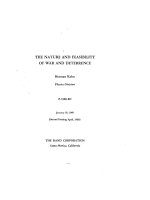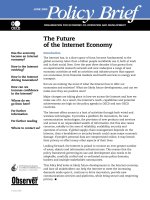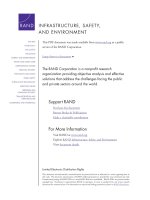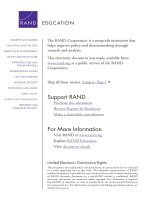Estimating the Benefits of the GridWise Initiative docx
Bạn đang xem bản rút gọn của tài liệu. Xem và tải ngay bản đầy đủ của tài liệu tại đây (411.29 KB, 79 trang )
This PDF document was made available from www.rand.org as a public
service of the RAND Corporation.
6
Jump down to document
Visit RAND at www.rand.org
Explore RAND Science and Technology
View document details
This document and trademark(s) contained herein are protected by law as indicated in a notice
appearing later in this work. This electronic representation of RAND intellectual property is provided
for non-commercial use only. Permission is required from RAND to reproduce, or reuse in another
form, any of our research documents for commercial use.
Limited Electronic Distribution Rights
For More Information
CHILDREN AND ADOLESCENTS
CIVIL JUSTICE
EDUCATION
ENERGY AND ENVIRONMENT
HEALTH AND HEALTH CARE
INTERNATIONAL AFFAIRS
POPULATION AND AGING
PUBLIC SAFETY
SCIENCE AND TECHNOLOGY
SUBSTANCE ABUSE
TERRORISM AND
HOMELAND SECURITY
TRANSPORTATION AND
INFRASTRUCTURE
U.S. NATIONAL SECURITY
The RAND Corporation is a nonprot research
organization providing objective analysis and effective
solutions that address the challenges facing the public
and private sectors around the world.
Purchase this document
Browse Books & Publications
Make a charitable contribution
Support RAND
This product is part of the RAND Corporation technical report series. Reports may
include research ndings on a specic topic that is limited in scope; present discus-
sions of the methodology employed in research; provide literature reviews, survey
instruments, modeling exercises, guidelines for practitioners and research profes-
sionals, and supporting documentation; or deliver preliminary ndings. All RAND
reports undergo rigorous peer review to ensure that they meet high standards for re-
search quality and objectivity.
Estimating the Benefits of
the GridWise Initiative
Phase I Report
WALTER S. BAER, BRENT FULTON,
SERGEJ MAHNOVSKI
TR-160-PNNL
May 2004
Prepared for the Pacific Northwest National Laboratory
The RAND Corporation is a nonprofit research organization providing objective analysis
and effective solutions that address the challenges facing the public and private sectors
around the world. RAND’s publications do not necessarily reflect the opinions of its research
clients and sponsors.
R
®
is a registered trademark.
© Copyright 2004 RAND Corporation
All rights reserved. No part of this book may be reproduced in any form by any electronic or
mechanical means (including photocopying, recording, or information storage and retrieval)
without permission in writing from RAND.
Published 2004 by the RAND Corporation
1700 Main Street, P.O. Box 2138, Santa Monica, CA 90407-2138
1200 South Hayes Street, Arlington, VA 22202-5050
201 North Craig Street, Suite 202, Pittsburgh, PA 15213-1516
RAND URL: />To order RAND documents or to obtain additional information, contact
Distribution Services: Telephone: (310) 451-7002;
Fax: (310) 451-6915; Email:
ISBN: 0-8330-3641-6
The research described in this report was prepared for the Pacific Northwest National
Laboratory by RAND Science and Technology.
iii
Preface
This report documents the results of the first phase of a two-phase study
conducted for the Office of Electricity Transmission and Distribution of the U.S.
Department of Energy (DOE) and the Pacific Northwest National Laboratory
(PNNL) to estimate the benefits that would result from implementing the
GridWise
TM
initiative, which is intended to accelerate the use of advanced
communication and information technologies in the U.S. electricity system. DOE
and PNNL seek a better understanding of the character and magnitude of
benefits—for electricity suppliers, end-users, and society at large—to inform both
public and private sector decisions about GridWise-related research and
development (R&D) and implementation strategies.
This study first develops an analytic framework for characterizing and
estimating such benefits, then makes preliminary quantitative estimates for the
most important benefit categories. The quantitative estimates represent gross
benefits that do not include R&D and implementation costs, which will be
estimated in Phase II of the study. Assumptions and other input variables for the
benefit calculations are clearly delineated, both to indicate the sensitivity of
benefit estimates to such inputs and to provide a basis for improving the
estimates in Phase II.
RAND Science and Technology
RAND Science and Technology (RAND S&T), a unit of the RAND Corporation,
conducts research and analysis that helps government and corporate
decisionmakers address opportunities and challenges created by scientific
innovation and rapid technological change. Our work stretches from emerging
energy technologies to global environmental change to still other endeavors
seeking a better understanding of the nation’s scientific enterprise and how best
to nurture it. Focal points of RAND S&T work include energy, the environment,
information technology, aerospace issues, technology and economic
development, bioethics, advanced materials, and “critical” technologies for
industries and occupations.
RAND S&T serves a variety of clients, including federal, state, and local
government agencies, foreign governments, foundations, and private
organizations. Our team has a wide range of expertise and includes physicists
iv
and geophysicists; chemists and geochemists; electrical, chemical, mechanical,
and information technology engineers; biological and environmental scientists;
and economists and other social scientists.
Inquiries regarding RAND Science and Technology may be directed to:
Stephen Rattien
Director, RAND Science and Technology
1200 South Hayes Street
Arlington, VA 22202-5050
Phone: (703) 413-1100 x5219
Email:
Website: www.rand.org/scitec
v
Contents
Preface iii
Figures vii
Tables ix
Summary xi
Acknowledgments xv
Acronyms and Abbreviations xvii
1. INTRODUCTION 1
The GridWise Vision 1
How GridWise Will Produce Benefits: An Overview 2
Increasing System Efficiency Through Demand Response 2
Using Load and Distributed Resources to Keep the Grid Stable 3
Improving Electricity System and End-User Operations 5
Study Objectives and Organization of this Report 5
2. A FRAMEWORK FOR ASSESSING GRIDWISE BENEFITS 7
Initial Taxonomy of Benefits 7
Building an Analytically Tractable Framework 8
Estimates Must Distinguish Intermediate from Final Benefits 9
Benefits Often Are Not Independent of Each Other 9
Externalities and Intangible Benefits Are Difficult to Quantify 11
3. PHASE I ESTIMATES OF GRIDWISE BENEFITS 12
System Benefits from GridWise-Enabled Demand Response 13
Microeconomic Framework for Demand Response Estimates 14
Linking Demand Response to System Capacity Decisions 16
Estimates of System Benefits from the Demand Response Model 17
Benefits from Improved Power Quality and Reliability 20
GridWise Impact on Power Outages and Disturbances 21
Current and Projected Costs of Power Outages and Disturbances 23
End-User Benefits from Improved Efficiency 25
Preliminary Estimates of Benefits 27
4. DISCUSSION 29
Comparison with Other Estimates of Benefits 29
Benefits Not Included in Phase I Estimates 32
5. PLANS FOR PHASE II 35
Appendix
A. Microeconomic Discussion of GridWise-Enabled Demand
Response 37
B. Baseline Projections, 2001–2025, Without GridWise 43
C. Results and Input Variables, by Scenario 49
D. Estimates of Benefits for Nominal Scenario 51
References 55
vii
Figures
S.1. Supplier and End-User Benefits from GridWise, by Scenario xiii
1.1. Projected GridWise Impact on a Typical Daily Load Curve 4
3.1. Electricity Market with Inelastic Demand, Pre-GridWise 15
3.2. Electricity Market with GridWise-Enabled Demand Response 15
3.3. System Benefits Resulting from Demand Response, by Scenario 21
3.4. Supplier and End-User Benefits from GridWise, by Scenario 27
4.1. GridWise Benefits for a Conservative Scenario, from Kannberg
et al., 2003 30
A.1. Electric Power Market, Off-Peak Without GridWise 38
A.2. Consumer Surplus During Peak Without GridWise 38
A.3. Electric Power Market, Off-Peak with GridWise 40
A.4. Offpeak Welfare Changes with GridWise 41
A.5. Electric Power Market, Peak with GridWise 42
A.6. Welfare Transfers at Peak with GridWise 42
ix
Tables
2.1. Initial Listing of Potential GridWise Benefits, by Stakeholder
Group 7
2.2. Intermediate and Final Benefits Enabled by GridWise 10
3.1. System Generating Capacity and Peak Demand, Without
GridWise 12
3.2. Electricity Consumption and Expenditure, by End-User Sector,
Without GridWise 13
3.3. Principal Input Variables and Range of Plausible Values,
Demand Response 18
3.4. System Capacity and Cost Deferrals, Nominal Scenario 19
3.5. System Benefits Resulting from Demand Response, by Scenario 20
3.6. Principal Input Variables and Range of Plausible Values, Power
Quality and Reliability 23
3.7. End-User Benefits from Improved Power Quality and Reliability,
by Scenario 24
3.8. Principal Input Variables and Range of Plausible Values for
Energy Efficiency 26
3.9. End-User Benefits from Level 3 EMS Efficiency, by Scenario 26
xi
Summary
This report presents the initial (Phase I) results of a two-phase project undertaken
to characterize and estimate the benefits of applying advanced communications
and information technologies, through the GridWise
TM
initiative, to bring the
aging U.S. electricity grid into the information age.
GridWise is a vision, a concept, and a national initiative developed by the U.S.
Department of Energy (DOE), the Pacific Northwest National Laboratory
(PNNL), and participants from the electricity industry. GridWise seeks to link
electricity suppliers and end-users with high-speed networks that provide real-
time information about system capacities, demand, prices, and status. Its
proponents anticipate that the integration of communications and information
with the electricity grid will facilitate competitive, efficient markets for power,
enable each participant to actively manage its own production and consumption
decisions, help the system balance supply and demand under both normal and
stressful conditions, and in general provide diagnostic information and tools to
better manage both system operations and end-user applications.
The essence of GridWise is the revealing of value to all parties through
information and communications, so that the least-cost resources are used to
meet new demand for power and its underlying infrastructure. Markets may be
the simplest and most transparent way to reveal value, but regulatory
approaches using incentives and resource bidding appear workable as well.
Whether in a regulated utility environment or in a deregulated market-based
system, advanced information and communications technologies are the keys to
revealing value and enabling stakeholders to act on the opportunities presented
to them. While this analysis relies on a competitive market model to characterize
and estimate benefits from implementing GridWise, we recognize that such
benefits may also be realized in a regulated system or in one with both
competitive and regulated components.
Smoothing out the daily peaks and valleys of electricity production and
consumption can benefit both electricity suppliers and end-users. With
GridWise, end-users will see time-varying prices that reflect high supply costs
when power consumption peaks and lower costs at other times. Users can then
adjust their peak and off-peak demands, either manually or by programming
their appliances and other electrical equipment to respond to price signals. This
xii
“demand response” will result in less power consumption during high-cost peak
periods and the shift of some peak usage to lower-cost off-peak times. Changes
in power usage due to demand response will generally be greater for commercial
and industrial facilities than for residential end-users. Overall, end-users will
gain from lower expenditures for power, while suppliers will benefit from
reduced operating costs and better utilization of their generation, transmission,
and distribution assets.
Enabling end-users to interact directly with the grid can also help the electricity
system respond to equipment failures, weather-related emergencies, and other
stressful conditions. At present, each of the ten North American Reliability
Council (NERC) regions must maintain enough excess generating capacity to
supply system demand if a large generating unit or transmission line fails. In the
GridWise concept, much of that reserve could be provided by smaller generating
units located at or near end-user sites or by end-user loads themselves. The
GridWise vision of collaborative networks, ubiquitous information flows,
distributed intelligence, and automated control systems promises important
additional benefits in terms of improved power quality, reliability, and security,
as well as energy efficiency.
The Phase I analysis develops a microeconomic framework for making
quantitative estimates of demand response and other benefits from the
widespread implementation and adoption of GridWise. To establish a baseline
without GridWise, we use the projections through 2025 of electricity system
capacities, power consumption, and prices contained in the most recent Annual
Energy Outlook (AEO) published by the U.S. Energy Information Administration.
We then phase in GridWise over 20 years and compare the results with those
from the AEO baseline.
To explore the sensitivity of benefits to the input data and assumptions, we
develop a series of scenarios representing different, but plausible, development
paths for GridWise. Benefits for each scenario are calculated as the present value
over 20 years of the cash flow differences from the AEO baseline projections.
Figure S.1 compares the benefits calculated for five scenarios:
•A “nominal” scenario with midrange values chosen for important input
variables such as GridWise market penetration among end-users and within
the transmission and distribution (T&D) grid; demand response parameters;
electricity market competitiveness; and GridWise impact on generating
reserve margins, power quality and reliability (PQR), and energy efficiency
in buildings.
xiii
Figure S.1. Supplier and End-User Benefits from GridWise, by Scenario
•A highly competitive and responsive markets scenario with higher values
for GridWise market penetration among end-users, demand response,
impact on generating reserve margins, and electricity market
competitiveness.
•A less competitive and responsive markets scenario with correspondingly
lower values for GridWise market penetration among end-users, demand
response, impact on generating reserve margins, and electricity market
competitiveness.
• A high-PQR-impact scenario with higher pre-GridWise costs of power
outages and disturbances for end-users and greater GridWise efficacy in
reducing these costs.
•A low-PQR-impact scenario with less GridWise efficacy in reducing outages
and disturbances.
The systemwide benefits from demand response accrue partly to industry
suppliers (the bottom segment of each bar) and partly to end-users (the next
segment of each bar). The split depends largely on the extent of market
competitiveness and responsiveness. In the nominal scenario, end-users receive
40 percent of the demand response benefits, passed on primarily as lower off-
peak prices, which result in lower total expenditures for power. Suppliers receive
the rest, benefiting from deferred and reduced costs that substantially outweigh
the impact of lower end-user spending. Including benefits from improved PQR
0
20
40
60
80
100
120
140
Nominal
scenario
Highly
competitive,
responsive
markets
Less
competitive,
responsive
markets
High impact
on power
reliability
Low impact
on power
reliability
Scenario
Present Value ($ billion)
End-users: reduced cost of
outages
End-users: lower
expenditures from
increased efficiency
End-users: lower
expenditures from demand
response
Suppliers: deferred and
reduced costs from demand
response
xiv
and energy efficiency brings the present value total of benefits to suppliers and
end-users to $81 billion.
When electricity markets are both highly competitive and responsive, end-users
receive an even larger share (60 percent); but the total benefits from demand
response are greater, so the industry suppliers also receive large benefits. Total
benefits, including improved PQR and energy efficiency, rise to $132 billion. In
the less competitive and responsive market scenario, suppliers get most of the
demand response benefits (75 percent), but there is considerably less to divide.
Total benefits, including improved PQR and energy efficiency, are only $32
billion, $100 billion less than those for the highly competitive and responsive
scenario. The last two scenarios in Figure S.1, in which GridWise has high and
low impact on power quality and reliability, yield total benefits of $115 billion
and $70 billion, respectively.
These results clearly show that the estimated gross benefits from GridWise can
be quite large, exceeding $100 billion in two of the five scenarios. However, the
variance among estimates is also very large, depending, of course, on the input
data and assumptions. At this early stage of GridWise development, many of the
input variables and projections are highly uncertain. Consequently, we believe
that delineating the range of benefits based on plausible input variables is more
useful than trying to converge on a single “best estimate.”
Our Phase I analysis does not include quantitative estimates of other categories
of possible GridWise benefits, notably,
• Lower costs of capital for generation, transmission, and distribution
investments.
• Integration of smaller-scale, distributed generation and related assets with
the grid.
• Reduced emissions and other environmental externalities.
• Intangible benefits.
• End-user productivity gains.
Based on our preliminary analysis, benefits in the first three categories appear to
have relatively small present values compared with those shown in Figure S.1.
The latter two categories could conceivably yield much larger benefits, but they
depend on assumptions that at this point seem very difficult to validate. In Phase
II of this project, we will evaluate these benefit categories more fully and will
develop estimates of the costs to implement GridWise.
xv
Acknowledgments
We acknowledge with thanks the insightful comments and suggestions we
received on earlier drafts from Clark Gellings (EPRI), Ingo Vogelsang (Boston
University and RAND), Robert Pratt (PNNL), John DeSteese (PNNL), Mark
Bernstein (RAND), and Sunil Cherion (Spirae, Inc.). We also benefited from
colleagues at RAND, PNNL, EPRI, DOE, and several other institutions who
contributed their data, knowledge, and advice to further this study. Finally, we
thank Lisa Sheldone and Janet DeLand, who helped us edit and prepare this
document for publication.
xvii
Acronyms and Abbreviations
AEO Annual Energy Outlook
CHP combined heat and power
DER distributed energy resources
DG distributed generation
DOE U.S. Department of Energy
DSM demand-side management
EIA U. S. Energy Information Administration
EMS energy management system
GDP gross domestic product
HVAC heating, ventilation, and air conditioning
kW, MW, GW kilowatt, megawatt, gigawatt
kWh kilowatt-hours
NERC North American Reliability Council
O&M operation and maintenance
OETD Office of Electric Transmission and Distribution
PNNL Pacific Northwest National Laboratory
PQR power quality and reliability
R&D research and development
RTP real-time pricing
T&D transmission and distribution
UPS uninterruptible power supply
1
1. Introduction
The GridWise Vision
The electricity system serving the United States, once a model of modernity for
the entire world, is in great need of modernization today. A recent paper
prepared by the Office of Electric Transmission and Distribution (OETD) of the
U.S. Department of Energy (DOE) states the problem succinctly:
America’s electric system, “the supreme engineering achievement of the
20
th
century,“ is aging, inefficient, and congested, and incapable of meeting
the future energy needs of the Information Economy without operational
changes and substantial capital investment over the next several decades.
1
Moreover, the OETD paper continues, “The revolution in information
technologies that has transformed other network industries in America (e.g.,
telecommunications) has yet to transform the electric power business.”
2
GridWise
TM
is a vision, a concept, and a national initiative developed by DOE,
the Pacific Northwest National Laboratory (PNNL), and industry leaders, with
the goal of
moving our industrial-age electrical grid into the information age.…
GridWise seeks to modernize the nation’s electric system—from central
generation to customer appliances and equipment—and create a
collaborative network filled with information and abundant market-based
opportunities…. Using advanced telecommunications, information and
control methods, we can create a “society” of devices that functions as an
integrated, transactive system.
3
Moving GridWise from vision to reality, however, will require large, sustained
efforts over many years and investments of many billions of dollars. Will the
benefits—to electricity suppliers, electricity end-users, and society at
large—justify the costs of developing and implementing GridWise? What are
those benefits, and how well can they be estimated today? These are the
principal questions this study explores.
_____________
1
OETD, 2003, p. iii.
2
Ibid, p. iv.
3
GridWise Alliance, 2003.
2
How GridWise Will Produce Benefits: An Overview
GridWise and related concepts of a future electricity system such as Grid 2030
(OETD, 2003), Electricity Sector Framework for the Future (EPRI, 2003b),
4
The
Smart Energy Network (Mazza, 2003), and The Energy Web (Silberman, 2001)
envision all suppliers and end-users linked by high-speed telecommunications
and information networks that provide real-time information about system
capacities, demand, prices, and status. Integration of communications and
information with the electricity system will facilitate competitive, efficient
markets for power; enable each participant to actively manage its own
production and consumption decisions; help the system balance supply and
demand under both normal and stressful conditions; and in general provide
diagnostic information and tools to better manage both system operations and
end-user applications.
The essence of GridWise is the revealing of value to all parties through
information and communications, so that the least-cost resources are used to
meet new demand for power and its underlying infrastructure.
5
Markets may be
the simplest and most transparent way to reveal value, but regulatory
approaches using incentives and resource bidding appear workable as well.
Whether in a regulated utility environment or in a deregulated market-based
system, advanced information and communications technologies are the keys to
revealing value and enabling stakeholders to act on the opportunities presented
to them. While this analysis relies on a competitive market model to characterize
and estimate benefits from implementing GridWise, we recognize that such
benefits may also be realized in a regulated system or in one with both
competitive and regulated components.
Increasing System Efficiency Through Demand Response
In a market environment, a critical component of GridWise-enabled information
flows will be dynamic end-user prices for electricity that are frequently updated
in line with the actual costs of generating and delivering power.
6
Dynamic
prices will reflect high supply costs when power consumption peaks and lower
_____________
4
EPRI, 2003a, and Gellings, 2003, present similar concepts for the future power delivery system.
5
Robert Pratt, PNNL, private communication, 2004.
6
Dynamic prices can take many forms, ranging from time-of-use prices, which are preset by
time of day or day of week, to real-time prices (RTP) that vary on an hourly basis or even more
frequently when electricity supply costs are volatile. This analysis posits that GridWise will enable
real-time dynamic prices. For further discussion of pricing alternatives, see Rosenfeld, Jaske, and
Borenstein, 2002; and Faruqui et al., 2002.
3
costs at other times. End-users receiving dynamic prices will be able to adjust
their peak and off-peak demands, either manually or by programming their
appliances and other electrical equipment to respond automatically to price
signals. This “demand response” will result in lower power consumption during
high-cost peak periods and the shift of some peak usage to lower-cost off-peak
times.
As one illustration, commercial and industrial cooling systems can use dynamic
price information to reduce energy costs while keeping temperatures within a
desirable range. On a hot day, the system can be programmed to run at full
capacity before and after the peak, so that it can use less power for cooling when
prices are highest. As a residential example, a household participating in a
dynamic pricing program could have a “smart meter” with programmable
controls to run the family dishwasher when electricity prices are low and avoid
washing when prices are high, thus lowering overall household expenditures for
power.
7
In general, changes in power usage due to demand response will be
greater for commercial and industrial facilities than for residential end-users.
Demand response not only benefits end-users but also increases the capacity
utilization and operating efficiency of the power system. Traditionally,
generation, transmission, and distribution capacities must be sized to handle
peak electrical loads and are underutilized at other times. As a result, the
national average load factor of all electricity system assets is only about 55
percent.
8
By reducing peak loads and “flattening” the daily demand pattern for
electricity (Figure 1.1), demand response makes it possible to supply electricity
reliably throughout the day and year with fewer generating plants and less
transmission and distribution (T&D) infrastructure, all operating at higher
capacity factors. Better asset utilization will improve the economic performance
of the electricity system as a whole and will bring financial benefits to most
electricity suppliers.
Using Load and Distributed Resources to Keep the Grid Stable
Enabling end-users to interact directly with the grid can also help the electricity
system respond to equipment failures, weather-related emergencies, and other
stressful conditions. At present, each of the ten North American Reliability
Council (NERC) regions must maintain enough excess generating capacity on
_____________
7
Such controls would be likely to include an override feature to permit running the appliance
at high-cost periods—for example, during a party.
8
OETD, 2003, p. 7.
4
Figure 1.1. Projected GridWise Impact on a Typical Daily Load Curve
line (spinning reserve) or quickly available (supplemental reserve) to continue
supplying system load if a large generating unit or transmission line fails. In the
GridWise concept, much of that reserve could be provided by smaller,
distributed generation (DG) units located at or near end-user sites
9
or by end-
user loads themselves.
As an example of utilizing loads as reserves, PNNL has designed computer chips
that can be integrated into refrigerators, air conditioners, hot-water heaters, and
other household appliances to continuously monitor the grid’s status.
10
If a Grid-
Friendly Appliance
TM
senses abnormal line frequency fluctuations, which are
often the first warning signs of generation or T&D inadequacy, it can be
programmed to shut down for a few seconds or minutes. Brief power
interruptions will not damage these appliances or degrade the services they
provide to the end-user; but isolating them from the grid, even momentarily, can
help relieve whatever stress the system may be experiencing. GridWise envisions
large numbers of Grid-Friendly Appliances not only helping the system respond
to stress or emergency situations
11
but also contributing to normal stabilization
_____________
9
Small-scale generators, energy storage units, and related facilities and equipment are known
as distributed energy resources (DER).
10
PNNL, 2003.
11
Again, an override feature is highly likely to be included as part of a Grid-Friendly
Appliance. Consequently, the actual response of the system must be estimated on a probabilistic basis
(Donnelly, 2003).
Hour of the Day
System
Load
(MW)
Base load
Peak
Intermediate
load
System load with
GridWise-enabled
demand response
System load pre-GridWise
5
functions known as ancillary services.
12
Beyond direct benefits to end-users from
greater reliability, using load and distributed resources as system reserves would
reduce the costs of building and maintaining centralized generating units for
these purposes.
Improving Electricity System and End-User Operations
The GridWise vision of collaborative networks, ubiquitous information flows,
distributed intelligence, and automated control systems suggests a myriad of
additional benefits, large and small, on both the supplier and end-user sides of
the smart meter. Networked monitoring devices coupled with smart diagnostic
tools can help transmission operators and distribution utilities identify
maintenance problems before they lead to equipment or infrastructure failures.
When natural disasters, accidents, or malicious acts occur, they can be detected
and repaired quickly, often through automated, “self-healing” grid responses.
For electricity end-users, the integration of networked information,
communication, and distributed controls will increase the value of a networked
energy management system (EMS) in residences, as well as in commercial and
industrial buildings.
13
GridWise-enabled information flows can also enhance
the value of customer investments in uninterruptible power supply (UPS) or
other equipment to protect sensitive end-user devices. In general, GridWise can
help end-users manage more efficiently not only their power usage but also the
power quality needed for their specific applications.
Distributed control systems will enable DER to be well integrated with grid
assets and infrastructure. This will not only improve overall system reliability
but will also enable end-users to sell power to the grid when prices exceed the
onsite generating cost and further improve the economics of using DER for
producing electricity or combined heat and power (CHP).
Study Objectives and Organization of this Report
This study was commissioned in the spring of 2003 to build an analytic
framework for estimating the benefits from the widespread implementation of
the GridWise concept and to make a quantitative net assessment of GridWise
benefits and costs. The project has been incrementally funded in two distinct
_____________
12
Kannberg, 2003. See also Ford, 2002, and Kirby and Hirst, 2003, for more detailed discussion
of ancillary services in the GridWise context.
13
Rabaey et al., 2001.









